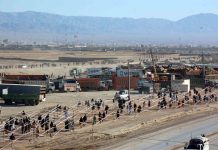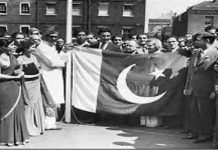Peshawar: The message on the wall is glaring and not just because it is black letters daubed on a stark white wall. In a place not long ago shattered by terrorism that displaced close to 2 m people, anything said or written about the subject still makes the residents of Swat take notice. Or in this case stand and stare, because the writing is on a wall along the roadside in Saidu Sharif, one of the towns most affected by militancy so brutal, people still talk about it in hushed tones.
“Suicide is forbidden (by religion),” says the text on the wall.
 Muhammad Talha, 15, has whitewashed the periphery wall around a roadside building clean before carefully scribbling the message with a brush. He now stands back and examines his work, like an artist appraising his painting. His brown shalwar kameez is speckled with white, his hands black.
Muhammad Talha, 15, has whitewashed the periphery wall around a roadside building clean before carefully scribbling the message with a brush. He now stands back and examines his work, like an artist appraising his painting. His brown shalwar kameez is speckled with white, his hands black.
“Today we see that a man is not at peace due to the machinations of his own brother,” Talha told News Lens Pakistan on the morning he and other madrassah students were out writing messages of peace on walls. “People are out to exploit differences and they seek to destroy others for their own gains. My message to them is ‘be brothers’ and live like brothers.”
 Pro-peace, anti-militancy graffiti may not be unusual in Swat valley that has suffered from some of the worst manifestation of militancy in the region – from frequent curfews to displacement and suicide attacks to public beheadings – between 2007 and 2009 when the military finally wrested control of the valley from the militants that wanted to impose Sharia in the region through brutal force. What is unusual about Talha’s message is that it comes from a student of madrassah, a religious institution often associated with radical views, much like the militants that threatened the peace of the valley.
Pro-peace, anti-militancy graffiti may not be unusual in Swat valley that has suffered from some of the worst manifestation of militancy in the region – from frequent curfews to displacement and suicide attacks to public beheadings – between 2007 and 2009 when the military finally wrested control of the valley from the militants that wanted to impose Sharia in the region through brutal force. What is unusual about Talha’s message is that it comes from a student of madrassah, a religious institution often associated with radical views, much like the militants that threatened the peace of the valley.
Talha, a student of Madrassa Darul Qura in Saidu Sharif. Not long ago, another student from the valley by the name of Malala Yousafzai was shot my militants for her pro-peace, anti-militancy views. Malala, the teenage education activist, went on to become the youngest Nobel laureate, championing the cause of education that militants wanted to stifle by destroying girls’ schools in the region.
Every day, after they are done with their lessons in madrassah, Talha and his fellow students are out on the roads of Saidu Sharif with paint and brushes, writing messages of brotherhood, peace and justice on walls to draw people’s attention to the “peaceful role” of seminaries and their students in the society.
 Wearing a brown cap that matches the colour of his clothes, Talha said he wanted to challenge and change the perception of people about madrassah and its students. “I want to show them the real face of madrassah.”
Wearing a brown cap that matches the colour of his clothes, Talha said he wanted to challenge and change the perception of people about madrassah and its students. “I want to show them the real face of madrassah.”
Talha’s and his fellow seminarians’ peace initiative is supported by Peace Education and Development Foundation (PEAD) that works on UN Children Fund’s Social Cohesion and Resilience programme in the district by involving religious seminaries.
Under SCR, UNICEF holds calligraphy and critical discussion forums for social cohesion and peace building in 6 madrassas in Swat to engage children and adolescents in healthy activities. The Fund recently scaled up this initiative in 30 madrassas and 30 formal schools in Swat, Peshawar and Kohat districts of Khyber Pakhtunkhwa province.
Tariq Hayat, who is program manager for PEAD, told News Lens that the joint activities aimed at increasing understanding about peace, tolerance and interfaith harmony among students of madrassah and state-run schools. “We do this by providing teachers, students and faith leaders an enabling environment for critical thinking, creative expression and open reflection.”
Hayat said it was hard to convince madrassah elders to launch a project of this nature. “It has been a gradual process of understanding on their part: to realize the importance of their role in promoting peace and now have allowed us to work with seminary students.”
He said the initiative successfully introduced cultural of dialogue inside religious seminaries by encouraging teachers and students to engage in discussions on a range of topics including cultural diversity, respect for humanity, social cohesion and resilience.
About 1200 student madrassah students are currently part of the calligraphy and art classes. “They are being trained to utilize the art of Islamic calligraphy to create awareness about the verses of the Holy Quran that emphasise peace, love and respect for humanity,” said Hayat.
According to PEAD, Talha is one of the most enthusiastic participants of the programme.
Talha thinks that people who believe that religious summaries students are narrow-minded and fundamentalists are wrong.
“How can people say that madrassahs are source of trouble and negativity when we are taught that patriotism is part of our faith?” says Talha.
Through our peace activities, I want people to know that “there are positive things that can be done to spread the message of peace and wall chalking like this may compel people to think about ways to express themselves in favour of peace.”
 The SCR activities carried out at madrassahs also underscore the importance of sports to engage youth in healthy activities and to wean them away from negative influences. Former Squash Champion Qamar Zaman said that it was the first time that he had seen madrassah students participating in games.
The SCR activities carried out at madrassahs also underscore the importance of sports to engage youth in healthy activities and to wean them away from negative influences. Former Squash Champion Qamar Zaman said that it was the first time that he had seen madrassah students participating in games.
“The word talib used for students in madrassahs has come to have negative connotation, creating misperception among people regarding seminary students or taliban because of the word’s association with terrorism,” said Zaman.
He said the government should provide funds and opportunities for ex-curricular activities in madrassahs.
“These brilliant students could earn laurels and bring Pakistan fame in the world of sports,” said Zaman.



